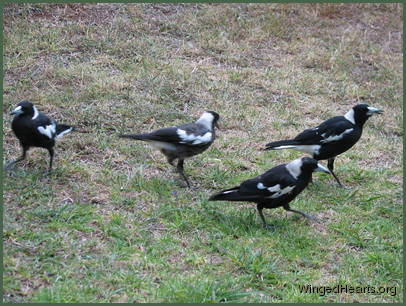Recognising Individual Birds - Part 3
In the previous posts we looked at two methods of recognising individual birds:
1. Using shape, form and size, and
2. Using their general characteristics.

In this post we'll examine another useful technique namely, identifying them from their posture and movement.
Birds are much like humans in this regard. Not only do they have unique physical features, shape and form - each bird also moves as uniquely as does each human being.
Some will amble, some will waddle and some will sway. Others will stand tall and upright while their twin will squat. Yet again another of their kin will step daintily, while another will keep their shoulders hunched.

(Picture above: Maggie magpie taking off.)
They are just as different in their flying, landing and taking off styles.
- Where do they like to land?
- From where do they like to take off.
- What are their favourite spots and perches?
- How easily do they fly?
- Observe their shapes, the fligt patterns and their styles.
Let's take a look at the the different ways birds can take off for their flight:
One will run a few steps before take off, another will make an arc, while yet another will hop or jump to a branch first before starting a flight.
Their landing styles are similarly distinctive:
(Picture below: Vicky magpie coming in to land.)

One bird will always land on a particular tree or bush before coming to the ground.
Another will alight on a fence.
Yet another will go straight for the perch on a post.
Some will come straight down only a foot or two in front of you.
Some will land a fair distance and then run or hop or walk towards you.
Observe the way the fly:
Take note of the angles at which they take off and the direction of the flight path.
- How much effort does one bird make compared to another?
- You will notice some are not as good at flying as their mates.
- While one will fly softly and swiftly, another will need to exert some effort.
- One will be able fly straight up in the air and change direction easily, while another will make huge arcs to achieve the same result.
As you begin to notice these different characteristics, a picture of each bird will begin to emerge in your mind and soon you will know each bird in a flash.
Tomorrow we will look at another easy way of recognising your bird.
For Part 1 of How To Recognise Individual Birds click here,
and for Part 2 on Recognising Individual Birds click here.
If you would like to know more about 23 Amazing Facts About Wild Bird Culture with true stories - click on this link and enter your details.
To read the earlier articles in this blog challenge click here.
Until tomorrow,
Cheers
Gitie

 del.icio.us
del.icio.us Digg
Digg Facebook
Facebook Google
Google Google+
Google+ LinkedIn
LinkedIn MySpace
MySpace Ping This!
Ping This! SlashDot
SlashDot StumbleUpon
StumbleUpon Twitter
Twitter Yahoo
Yahoo





